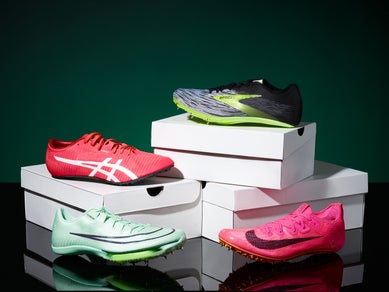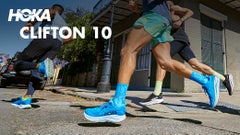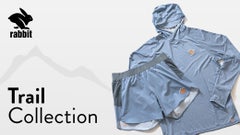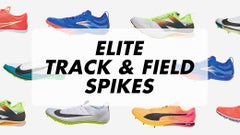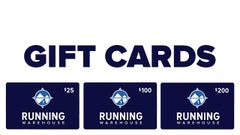The Best Middle and Long Distance Spikes of 2025
Updated: February 10, 2025 by Loucas Kobold

We get goosebumps for the roar of the crowd and the adrenaline surge as the bell rings for the final lap of a distance race under the bright lights of the track. Runners summon their final push, fight for position, and give their all to kick for a place on the podium and in the record books. And with the latest advanced footwear technology, i.e. superfoams and carbon plates, it has never been more fun to toe the line. Below, we have compiled a list of the best distance spikes on the market. From experienced athletes to beginners, we have the distance spikes you need to get the ultimate edge and your best times yet.
For a detailed explanation of how we test shoes and why you should trust our recommendations, read about our running shoe testing methodology.
What Makes a Spike Good For Distance?
Distance events are generally split into two categories: middle-distance and long-distance. Middle distance track events include the 800m, 1500m, and 1600m, while long distance track events include the 3000m, 3200m, 5000m, and 10,000m events.
Likewise, distance track spikes are categorized as either middle-distance spikes or long-distance spikes. Both types are similar in terms of weight and fit (more relaxed than sprint spikes, but will still be contoured and snug), but vary slightly in their characteristics. Mid-distance spikes generally will have a more aggressive design, such as a stiffer and/or longer plate or a greater number of pins in a specific layout, all with the goal of getting runners on their toes as fast as possible.
Long-distance spikes generally will be the lightest possible weight, more flexible, and the most cushioned throughout (especially under the heel and midfoot, compared to mid-distance), all to be more forgiving and keep your legs fresher over longer distances.
In terms of cushioning level, it really is a matter of personal preference, unless you want the maximum possible amount of energetic superfoam. And while we usually don't recommend using a mid-distance spike for a long-distance event simply from a comfort perspective, it's not unusual to see long-distance spikes being worn during mid-distance races. The latest batches of highly cushioned super spikes definitely blur the lines between mid and long, with several models proving highly capable across a very broad range of distances.
Our Top Picks for the Best Distance Spikes of 2025
- Best Spikes for Middle Distance Events (800m / 1500m / 1600m) Nike Air Zoom Victory 2
- Best Spikes for Long Distance Events (3000m / 3200m / 5000m / 10,000m) Nike ZoomX Dragonfly 2 / Elite
- Best Distance Spikes for Beginners Nike Zoom Rival Distance
Best Overall Middle Distance Spikes
Nike Air Zoom Victory 2

Embodying speed, it's no surprise that the new Nike Air Zoom Victory 2 is undeniably our Best Overall pick. This super spike is unbelievably light and aggressive, with ZoomX foam and a dual-chambered Air Zoom unit paired with a full-length carbon fiber plate.
We love this bleeding-edge bestseller for its unsurpassed, championship-winning, elite-level performance. As seen on the feet of so many of the best athletes worldwide, it's the perfect pick for anyone looking to gain an edge and race to a new PR in events ranging from 800m to the mile.
| At a glance: Nike Air Zoom Victory 2 |
|
Honorable Mention Best Middle Distance Spikes
New Balance FuelCell SuperComp MD-X v3

Not to be overlooked, we need to recognize the New Balance FuelCell SuperComp MD-X v3 as a ridiculously worthy and championship-decorated competitor for the top pick in this category. Loaded with premium features like 100% PEBA superfoam and a full-length carbon fiber plate, this spike delivers world-class speed.
As our pick for exceptional versatility due to its stunningly broad range, the SuperComp MD-X's optimum performance encompasses events spanning from 800m to 5000m distances.
| At a glance: New Balance FuelCell SuperComp MD-X v3 |
|
Best Overall Long Distance Spikes
Nike ZoomX Dragonfly 2 / Elite

Just in case we thought the best couldn't get better, Nike gave the most dominant long distance spike in history a killer update and a separate god-tier version: the ZoomX Dragonfly 2 and ZoomX Dragonfly 2 Elite.
When both versions have ultimate responsiveness with an unreal cushioning-to-weight ratio, what's not for us to love? To differentiate, the Dragonfly 2 continues the purposeful usage of a Pebax plate, which is generally more flexible and slightly lighter weight than carbon fiber. This plate is also lighter and more responsive than the previous OG Dragonfly. The Elite opts for a full carbon fiber plate for maximum stiffness and propulsion while reducing weight even further than its sibling.
Rest assured that Dragonfly super spikes have been used to set multiple world records in the 5K and 10K. Now, distance runners everywhere have access to these devastatingly efficient tools, both crafted to carry you to stunning times.
| At a glance: Nike ZoomX Dragonfly 2 / Elite |
|
Honorable Mention Best Long Distance Spikes
Saucony Terminal VT

With an abundance of deserving top-tier options from many brands, we almost always feel torn when highlighting just one overall top pick or honorable mention. In a tossup with the adidas adizero Ambition, we're giving the nod to the phenomenal Saucony Terminal VT super spikes due to their practically nonexistent weight.
Featuring a full-length PWRRUN HG superfoam, we recognize that "Hg" is the chemical symbol for the element mercury (appropriately named for the Roman god of speed), but "HG" might as well stand for "Helium-filled Gravity-defiance" too, while we're at it.
In physics, VT can signify Terminal Velocity or Velocity and Time. In a sport where every fraction of a second counts, the weight of your spikes holds immense importance, and this is where the Terminal VT excels — helping you reach your fastest speeds for your quickest times yet.
| At a glance: Saucony Terminal VT |
|
Best Overall Distance Spikes for Beginners
Nike Zoom Rival Distance

In the field of beginner spikes, without a doubt in our minds or books, the Nike Zoom Rival Distance easily leads the way industry-wide. This versatile "can't-go-wrong" option has enough cushioning and speed for any new or up-and-coming runner trying to find their sweet spot on the track without breaking the bank and is a solid choice for fit and performance.
| At a glance: Nike Zoom Rival Distance |
|
Honorable Mention Best Distance Spikes for Beginners
HOKA Crescendo MD 2

The HOKA Crescendo MD 2 is a highly cushioned entry-level track spike with an aggressive 6-pin plate to rip hot laps on the track. While the "MD" in the name stands for "mid distance," we see these spikes as capable from 400m to 3200m and beyond. Its broader range and a thicker stack of comfortable foam swayed us to give it the nod in a tossup with New Balance MD 500 v9 (if you need an added option to consider). As a bonus, if you could benefit from an extra instep volume or arch space, the budget-friendly and versatile Crescendo also historically fits slightly more spaciously than many other track spikes.
| At a glance: HOKA Crescendo MD 2 |
|
FAQ
1. What’s the difference between mid-distance and long-distance track spikes?
Mid distance spikes blur the lines between sprint spikes and long distance spikes. Sprint spikes commonly don't feature any heel cushioning and they tend to be stiffer, sturdier, and heavier to handle peak forces. At the other end, long distance spikes feature the tallest amounts of full-length cushioning and they're built to be the absolute lightest weight possible. Meeting in the middle, mid distance spikes blend these features and are a bit more aggressive than their longer distance counterparts, in general. Compared to long distance spikes, mid distance options often have more pins in the forefoot, longer or stiffer plates or shanks, slightly less cushioning under the rearfoot, and might be just slightly heavier and sturdier.
2. How do I choose the right track spikes for mid-distance or long-distance running?
We recommend reviewing the information on the spikes we provide and thoughtfully considering how well it matches your needs, intended purposes, and events. Chat with your coach, and don't hesitate to contact us by live chat, email, or phone - we'd love to help! As with all running footwear, the most important deciding factor is what fits and feels best to YOU.
3. What are the top features to look for in a mid-distance or long-distance track spike?
Some of the main features for a top-notch super spike include one of the latest superfoams (usually PEBA/Pebax, TPEE, or A-TPU) and likely paired with a full-length plate made out of high-performance thermoplastic (such as Pebax), fiberglass, or most likely carbon fiber. And, of course, if all else is equal, lighter is better (ask Bill Bowerman). Ultimately, the lightest weight option might not be best for you, so ensure your spikes have the right cushioning level and support for your preferences.
4. How do I know if my track spikes fit correctly?
We know the fit of track spikes can be tricky, for sure. Unlike typical running shoes, spikes aren't built for comfort but for performance. Compared to shoes, spikes will automatically fit narrower and snugger, with less structured or supportive uppers, all for racing performance. For shoes, we recommend having a thumbnail's width of space in front of your longest toe. For spikes, it's normal for the ends of your toes to be much closer to the end, but your feet still shouldn't be crammed. For the most part, start by trying your spikes in the standard size you usually wear for training shoes. The spikes will feel smaller than you're used to; make sure they feel quite secure (not too loose, no heel slipping) without being OVERLY tight (still a touch of room for toe comfort). Think about how long you'll have to wear your spikes (how many minutes your race will take, plus a handful of minutes before and after), and remember you can do part of your warm up in shoes before switching to your spikes. Check out our comprehensive guide on How to Fit Track and Field Spikes for more in-depth guidance.
5. How often should I replace my track spikes for mid or long-distance running?
Since the vast majority of spikes have replaceable pins instead of permanent pins, it's not uncommon to lose at least 1 or 2 pins at almost every track meet. For spikes in general (the entire shoe, including the upper, foam, plate, and outsole), depending on the frequency and the number of meets, they'll often be completely used up and broken down after one full school season.
6. Are there differences in spikes for synthetic tracks vs. natural (grass, dirt) tracks? What about pavement?
As a general rule of thumb, the fancier top-end spikes are best on synthetic/rubber tracks. From a personal comfort and spike durability perspective, most entry-level or simpler spikes can fare slightly better on dirt and grass. Observe closely and feel the outsole material along the full length of your spike - would you want that outsole on slippery grass or hard-packed dirt that might have rocks to step on? If you're racing on a hard paved track, we'd recommend spikeless/flat/waffle options or a performance road shoe, if allowed. Try not to walk across the pavement with your spikes on, especially if the sharp pins are inserted - that's what the carrying bag (included in the shoe box for many models) is for.
7. Can I use the same spikes for both mid-distance and long-distance events?
While you can use the same spikes for both distance events, it's significantly more comfortable to use long distance spikes for mid distance events than vice versa. Many mid distance spikes have enough range versatility to go long distance, but it depends on your comfort level in them.
8. How do I care for my track spikes to maximize their lifespan?
Try to use your spikes only on soft track surfaces and when you have to for racing and some practice. Carry your spikes and keep them in a separate bag when not in use. If you want, gently wipe away dirt, grit, and moisture after use before putting them away. Properly unlace your spikes instead of smashing your feet in them repeatedly or pulling them off while still tied.
9. Do I need to take the pins out after each track meet?
You don't need to take the pins out each time, but you'll likely want to tighten some of them back up with the included spike tool. Snug the pins, and don't overtighten them or get them cross-threaded when inserting them for the first time.
10. Are track spikes allowed in all running events and meets?
Track spikes are only for the track, and your coach will know best about what is and isn't allowed at each of your meet locations. If spikes are permitted, the "standard" pins are usually pyramid-shaped and 1/4-inch length or shorter. Many facilities discourage longer lengths and other shapes, such as needles, but virtually all track spikes come with standard pyramid spikes in the box.

